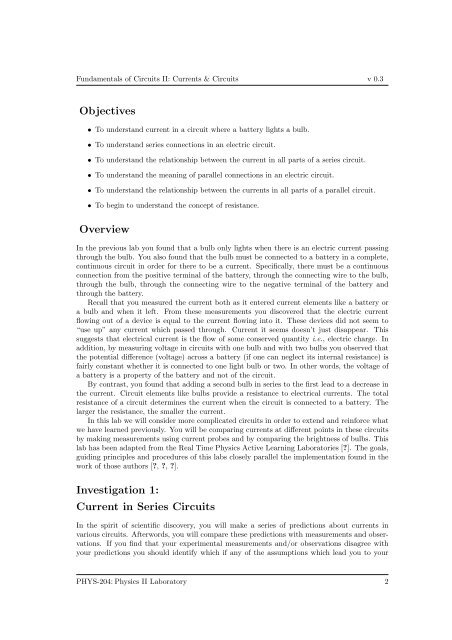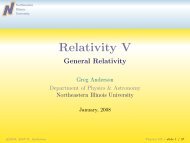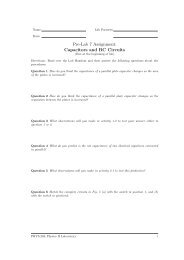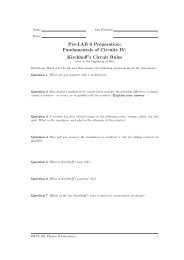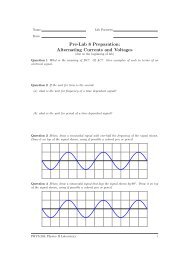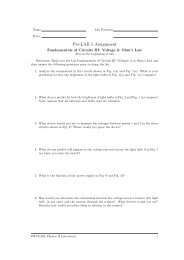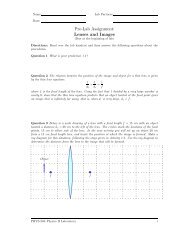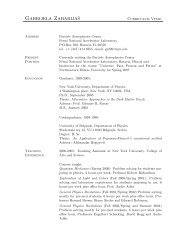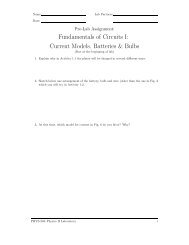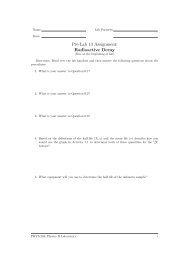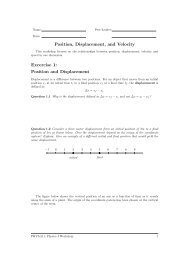Pre-LAB 4 Assignment Fundamentals of Circuits II: Currents ...
Pre-LAB 4 Assignment Fundamentals of Circuits II: Currents ...
Pre-LAB 4 Assignment Fundamentals of Circuits II: Currents ...
You also want an ePaper? Increase the reach of your titles
YUMPU automatically turns print PDFs into web optimized ePapers that Google loves.
<strong>Fundamentals</strong> <strong>of</strong> <strong>Circuits</strong> <strong>II</strong>: <strong>Currents</strong> & <strong>Circuits</strong> v 0.3<br />
Objectives<br />
• To understand current in a circuit where a battery lights a bulb.<br />
• To understand series connections in an electric circuit.<br />
• To understand the relationship between the current in all parts <strong>of</strong> a series circuit.<br />
• To understand the meaning <strong>of</strong> parallel connections in an electric circuit.<br />
• To understand the relationship between the currents in all parts <strong>of</strong> a parallel circuit.<br />
• To begin to understand the concept <strong>of</strong> resistance.<br />
Overview<br />
In the previous lab you found that a bulb only lights when there is an electric current passing<br />
through the bulb. You also found that the bulb must be connected to a battery in a complete,<br />
continuous circuit in order for there to be a current. Specifically, there must be a continuous<br />
connection from the positive terminal <strong>of</strong> the battery, through the connecting wire to the bulb,<br />
through the bulb, through the connecting wire to the negative terminal <strong>of</strong> the battery and<br />
through the battery.<br />
Recall that you measured the current both as it entered current elements like a battery or<br />
a bulb and when it left. From these measurements you discovered that the electric current<br />
flowing out <strong>of</strong> a device is equal to the current flowing into it. These devices did not seem to<br />
“use up” any current which passed through. Current it seems doesn’t just disappear. This<br />
suggests that electrical current is the flow <strong>of</strong> some conserved quantity i.e., electric charge. In<br />
addition, by measuring voltage in circuits with one bulb and with two bulbs you observed that<br />
the potential difference (voltage) across a battery (if one can neglect its internal resistance) is<br />
fairly constant whether it is connected to one light bulb or two. In other words, the voltage <strong>of</strong><br />
a battery is a property <strong>of</strong> the battery and not <strong>of</strong> the circuit.<br />
By contrast, you found that adding a second bulb in series to the first lead to a decrease in<br />
the current. Circuit elements like bulbs provide a resistance to electrical currents. The total<br />
resistance <strong>of</strong> a circuit determines the current when the circuit is connected to a battery. The<br />
larger the resistance, the smaller the current.<br />
In this lab we will consider more complicated circuits in order to extend and reinforce what<br />
we have learned previously. You will be comparing currents at different points in these circuits<br />
by making measurements using current probes and by comparing the brightness <strong>of</strong> bulbs. This<br />
lab has been adapted from the Real Time Physics Active Learning Laboratories [?]. The goals,<br />
guiding principles and procedures <strong>of</strong> this labs closely parallel the implementation found in the<br />
work <strong>of</strong> those authors [?, ?, ?].<br />
Investigation 1:<br />
Current in Series <strong>Circuits</strong><br />
In the spirit <strong>of</strong> scientific discovery, you will make a series <strong>of</strong> predictions about currents in<br />
various circuits. Afterwords, you will compare these predictions with measurements and observations.<br />
If you find that your experimental measurements and/or observations disagree with<br />
your predictions you should identify which if any <strong>of</strong> the assumptions which lead you to your<br />
PHYS-204:Physics <strong>II</strong> Laboratory 2


